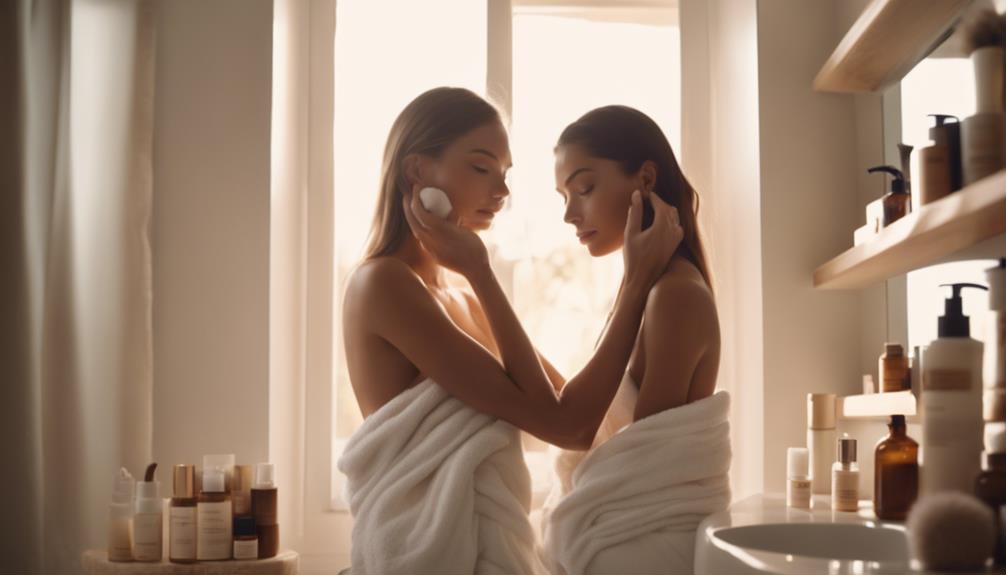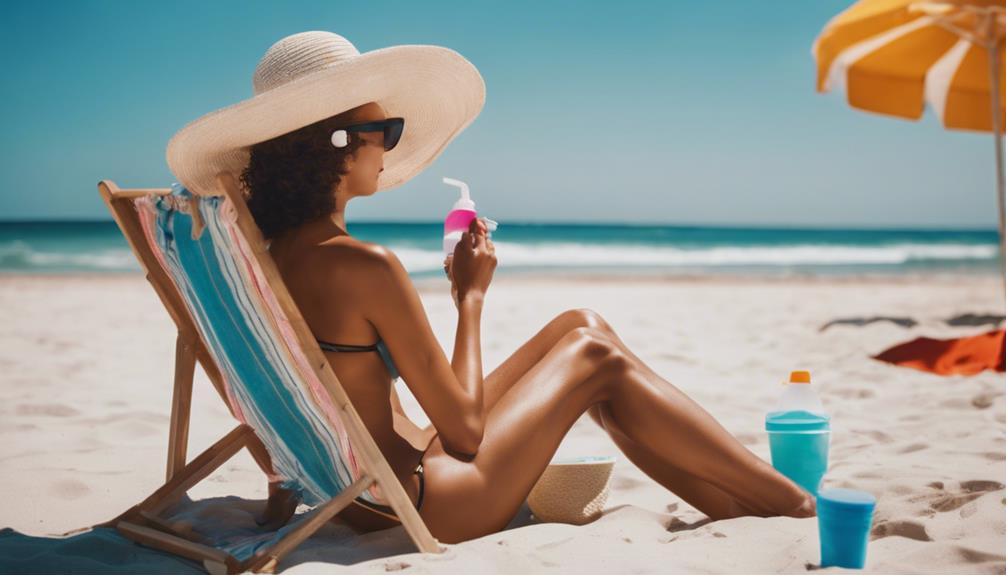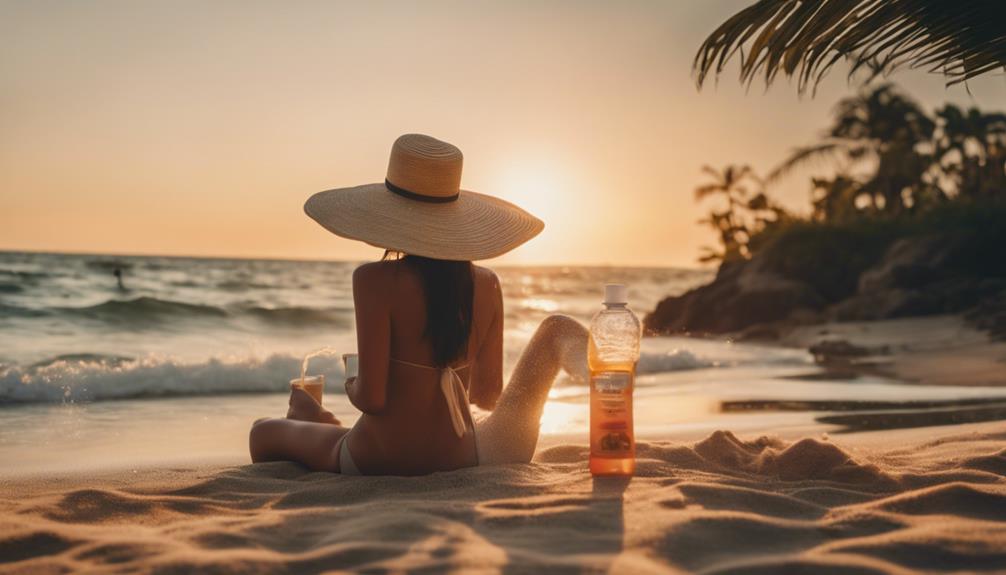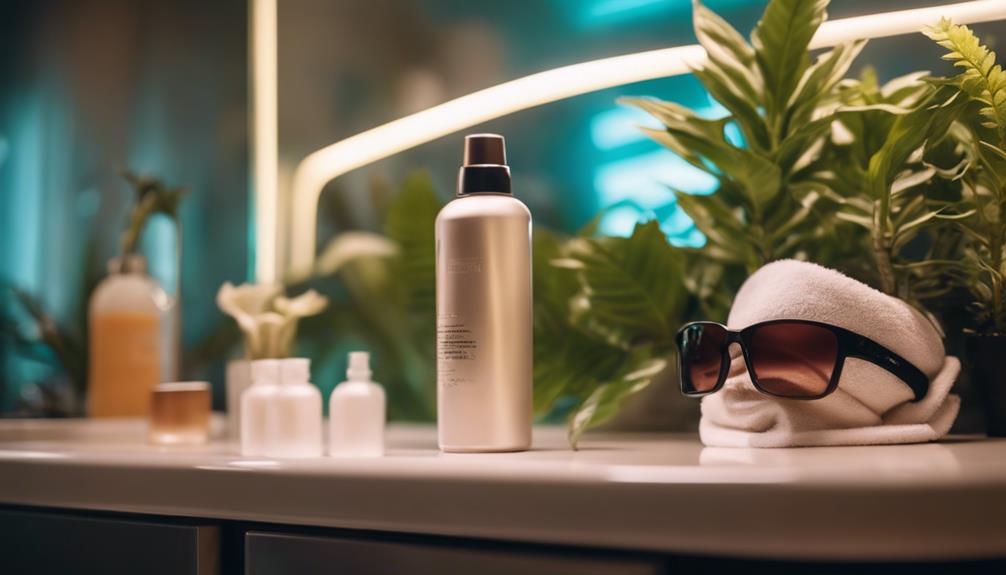Revealing the tips for safe tanning involves several important steps. First, it’s important to determine your skin type and do patch tests to understand your sensitivity to UV rays. Choose tanning lotions that enhance melanin production and avoid those with SPF for optimal results. Protect your eyes by wearing UV-blocking goggles to shield them from the sun’s rays. It’s crucial to gradually increase your exposure to tanning sessions, starting with shorter periods and allowing time for your skin to recover in between. After tanning, soothe your skin with aloe vera and keep it hydrated with moisturizers. By following these recommendations, you can achieve a beautiful tan while reducing the risks associated with tanning. There is much more to learn about effective tanning techniques and products.
Key Takeaways
- Assess your skin type and conduct patch tests to determine UV sensitivity before tanning.
- Choose indoor tanning lotions with melanin-boosting and hydrating ingredients for optimal results.
- Always wear UV-blocking goggles to protect your eyes from harmful UV radiation.
- Follow a gradual tanning schedule, allowing 48 hours between sessions for skin recovery.
Skin Assessment and Preparation
A thorough skin assessment and preparation are essential steps in ensuring a safe and effective indoor tanning experience.
Identifying skin type is critical; conducting patch tests prior to tanning can help gauge individual reactions to UV exposure and prevent adverse effects. Consulting with professionals or performing patch tests allows individuals to start with shorter tanning sessions, enabling the skin to acclimatize gradually.
Additionally, proper skin preparation involves showering and exfoliating the day before the session, followed by the application of a non-oily moisturizer to enhance tanning results.
It is also crucial to check for any medications that may increase UV sensitivity and to use SPF lip balm to protect the lips during tanning sessions, ensuring thorough skin protection.
Choosing Tanning Lotions
Selecting the right tanning lotion is essential for optimizing results and ensuring skin safety during indoor tanning sessions. It is vital to choose products that enhance tanning effects while providing necessary hydration.
Key considerations include:
- Melanin-boosting ingredients: Look for lotions designed to enhance the natural tanning process, promoting a deeper and longer-lasting tan.
- Hydration properties: Select lotions that contain moisturizing components to prevent skin dryness and maintain a healthy appearance.
Importance of Eye Protection

Choosing the right tanning lotion greatly enhances the tanning process, but equal attention must be given to protecting the eyes from harmful UV exposure during indoor tanning sessions.
The sensitive tissues of the eyes are particularly vulnerable to UV radiation, which can lead to short-term discomfort and long-term damage, including cataracts and retinal burns. As a result, it is vital to wear proper protective eyewear, such as UV-blocking goggles, that fit securely and comfortably.
Contact lenses do not provide adequate UV protection, making goggles indispensable. Additionally, consulting tanning professionals for advice on suitable eyewear and replacing damaged goggles can further guarantee peak eye safety.
Prioritizing eye protection is essential for a thorough approach to safe tanning practices.
Tanning Schedule Management
Establishing a well-structured tanning schedule is crucial for achieving ideal results while minimizing the risk of skin damage.
A personalized approach, considering individual skin characteristics, guarantees optimal tanning outcomes.
Begin with shorter sessions to allow the skin to acclimatize, adhering to the following guidelines:
- Allow at least 48 hours between sessions to promote skin recovery and melanin production.
- Limit tanning sessions to 1-3 times per week for balanced exposure and to prevent overexposure.
Post-Tanning Skin Care

Effective post-tanning skin care is essential for maintaining a radiant glow and guaranteeing the skin recovers properly after UV exposure.
After tanning, it is vital to soothe the skin to minimize redness and irritation. Applying aloe vera immediately after the session can provide relief and support the healing process.
Incorporating a nightly moisturizing routine with a rich, creamy moisturizer helps maintain skin health and prolongs the tan. Additionally, using a tan extender lotion following each tanning session will lock in moisture and enhance color longevity.
It is advisable to avoid SPF products during nighttime, as they can interfere with the tanning routine.
Consistent care will guarantee that your tan remains vibrant while keeping the skin nourished and healthy.
Hydration and Moisturization Tips
Maintaining proper hydration and moisturization is essential for enhancing the results of indoor tanning and ensuring the skin remains healthy and radiant.
Adequate hydration helps to prevent dryness and irritation, while consistent moisturization keeps the skin supple and vibrant.
To optimize your tanning experience, consider the following tips:
- Drink plenty of water: Hydrate from within to maintain skin elasticity and support overall skin health.
- Apply tan extender lotion: Use a specially formulated lotion post-tanning to lock in moisture and prolong your tan.
Best Practices for Safe Tanning

Implementing best practices for safe tanning is crucial to minimizing risks while achieving a desirable tan.
Begin with a thorough skin assessment to identify your skin type and conduct patch tests. Use indoor tanning lotions specifically formulated for your skin, focusing on those with melanin-boosting properties while avoiding SPF to enhance tanning efficacy.
Always wear protective eyewear to shield your eyes from harmful UV rays. Establish a gradual tanning schedule, allowing at least 48 hours between sessions to promote skin recovery.
Post-tanning care is important; hydrate your skin with rich moisturizers and aloe vera to soothe any irritation.
What are the essential tips for safe tanning?
When it comes to essential tips for tanning safety, always make sure to apply sunscreen with a high SPF to protect your skin from harmful UV rays. Limit your sun exposure, especially during peak hours, and consider using a self-tanning product for a safer alternative to achieve a sun-kissed glow.
Conclusion
In summary, achieving a radiant, sun-kissed complexion requires meticulous attention to safe tanning practices.
By prioritizing skin assessment, selecting appropriate tanning products, and adhering to a well-structured schedule, individuals can access the golden glow that many aspire to attain.
Post-tanning care, along with proper hydration and moisturization, plays a pivotal role in maintaining skin health.
Ultimately, embracing these essential guidelines transforms the tanning journey into an art form, ensuring that the pursuit of a flawless tan is both safe and rewarding.










